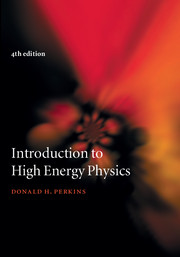Book contents
- Frontmatter
- Contents
- Preface
- 1 Quarks and leptons
- 2 Interactions and fields
- 3 Invariance principles and conservation laws
- 4 Quarks in hadrons
- 5 Lepton and quark scattering
- 6 Quark interactions and QCD
- 7 Weak interactions
- 8 Electroweak interactions and the Standard Model
- 9 Physics beyond the Standard Model
- 10 Particle physics and cosmology
- 11 Experimental methods
- Appendix A Table of elementary particles
- Appendix B Milestones in particle physics
- Appendix C Clebsch–Gordan coefficients and d-functions
- Appendix D Spherical harmonics, d-functions and Clebsch–Gordan coefficients
- Appendix E Relativistic normalisation of cross-sections and decay rates
- Glossary
- Answers to problems
- Bibliography
- References
- Index
2 - Interactions and fields
Published online by Cambridge University Press: 05 June 2012
- Frontmatter
- Contents
- Preface
- 1 Quarks and leptons
- 2 Interactions and fields
- 3 Invariance principles and conservation laws
- 4 Quarks in hadrons
- 5 Lepton and quark scattering
- 6 Quark interactions and QCD
- 7 Weak interactions
- 8 Electroweak interactions and the Standard Model
- 9 Physics beyond the Standard Model
- 10 Particle physics and cosmology
- 11 Experimental methods
- Appendix A Table of elementary particles
- Appendix B Milestones in particle physics
- Appendix C Clebsch–Gordan coefficients and d-functions
- Appendix D Spherical harmonics, d-functions and Clebsch–Gordan coefficients
- Appendix E Relativistic normalisation of cross-sections and decay rates
- Glossary
- Answers to problems
- Bibliography
- References
- Index
Summary
Classical and quantum pictures of interactions
Classically, interaction at a distance, e.g. in electromagnetism, is described in terms of a potential or field due to one charged particle acting on another, the field permeating the whole of space around the source charge. A conceptually more appealing idea, perhaps, is that of an exchange interaction, where the object exchanged carries momentum from one charge to the other, the rate of exchange of momentum providing the force. A frequently quoted everyday example is of two ice-skaters travelling side by side, initially moving parallel, who start to diverge as they repel one another by throwing a ball back and forth.
In quantum theory, action at a distance is indeed viewed in terms of an exchange interaction, the exchange being of a specific quantum (a boson) associated with the particular type of interaction. Since the quantum carries momentum and energy, say ΔE, the conservation laws can only be satisfied if the process takes place within a timescale Δt limited by the Uncertainty Principle, i.e. ΔE Δt ≃ ħ. Such transient quanta are said to be virtual.
The quantum concept of an electromagnetic interaction is of the continual exchange (emission and absorption) of virtual photons by the charges, which is no more or less fictitious than the classical concept of an all-pervading field surrounding a source charge. Neither the field nor the virtual quanta are directly observable; it is the force that is the measured quantity.
Information
- Type
- Chapter
- Information
- Introduction to High Energy Physics , pp. 35 - 62Publisher: Cambridge University PressPrint publication year: 2000
